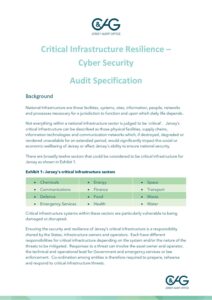
Monday 23 June 2025 - Audit Specification
Monday 23 June 2025 - Audit Specification
Topics: Data Security
Departments: All
Sector: All

Audit Specification: pdf (191.57 KB)
Download in full ↓National Infrastructure are those facilities, systems, sites, information, people, networks and processes necessary for a jurisdiction to function and upon which daily life depends.
Not everything within a national infrastructure sector is judged to be ‘critical’. Jersey’s critical infrastructure can be described as those physical facilities, supply chains, information technologies and communication networks which, if destroyed, degraded or rendered unavailable for an extended period, would significantly impact the social or economic wellbeing of Jersey or affect Jersey’s ability to ensure national security.
There are broadly twelve sectors that could be considered to be critical infrastructure for Jersey. These are:
Critical infrastructure systems within these sectors are particularly vulnerable to being damaged or disrupted.
Ensuring the security and resilience of Jersey’s critical infrastructure is a responsibility shared by the States, infrastructure owners and operators. Each have different responsibilities for critical infrastructure depending on the system and/or the nature of the threats to be mitigated. Responses to a threat can involve the asset owner and operator, the technical and operational lead for Government and emergency services or law enforcement. Co-ordination among entities is therefore required to prepare, rehearse and respond to critical infrastructure threats.
Cyber resilience is the overall ability of systems and organisations to withstand cyber events and, where harm is caused, recover from them. Critical infrastructure systems are prime targets for cyber-attacks due to their vital role in society. Potential cyber security threats do not just affect data and systems in government and business, but also critical infrastructure, including emergency services, energy, health, transport and water.
In October 2017, the Government published its Cyber Security Strategy. The Strategy is centred around the following five pillars:
To protect the Island, there is a need for Government to work with the private sector and the operators of critical national infrastructure. In addition, there is a need for Government to have robust cyber security arrangements over its own operations.
The Jersey Cyber Security Centre (JCSC) was established in 2021 to promote and improve the Island’s cyber resilience. It operates on an arm’s length basis from Government.
The Government of Jersey has invested and is investing in a cyber security programme focussed on Government of Jersey IT systems and related infrastructure to improve its own arrangements.
In May 2022 the C&AG published a report on Cyber Security Arrangements which focussed on the Government’s cyber security programme at that time.
The States are due to debate a new draft Cyber Security Law during 2025.
The audit’s overall objective is to assess whether the Government has an effective approach to cyber resilience.
The scope of the audit will include:
· the Government’s cyber security programme
· emergency services and how they are integrated into cyber security governance arrangements
· how operators within the energy sector are integrated into cyber security governance arrangements
· how telecommunications operators are integrated into cyber security governance arrangements; and
· the arrangements in respect of the JCSC.
The audit will not consider arrangements in respect of private sector businesses on the Island.
To assess if the Government’s efforts to improve cyber security are providing value for money, the audit will consider whether:
· clear, risk-based cyber resilience outcomes have been set for the programmes and arrangements put in place within the States
· the right support, incentives and monitoring procedures have been established to provide assurance over cyber security arrangements relating to critical infrastructure operated by the States of Jersey Group and by asset owners in the telecommunications and energy sectors; and
· actions taken by the States and the JCSC have appropriately prioritised, and built the capability to deliver, the cyber security they need to operate effectively.
The audit criteria will include the following aspects of cyber security governance arrangements:

Associate Member of EURORAI - a cooperation project between public sector supervisory bodies in Europe